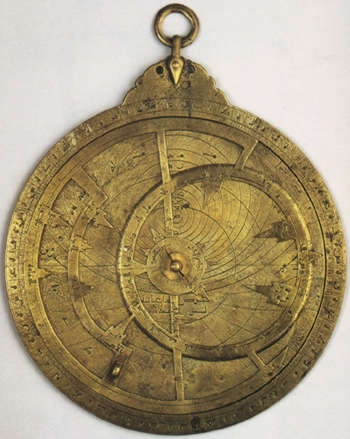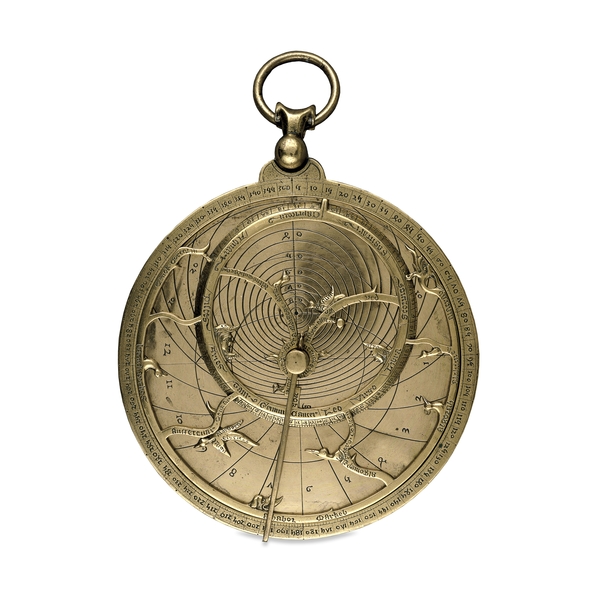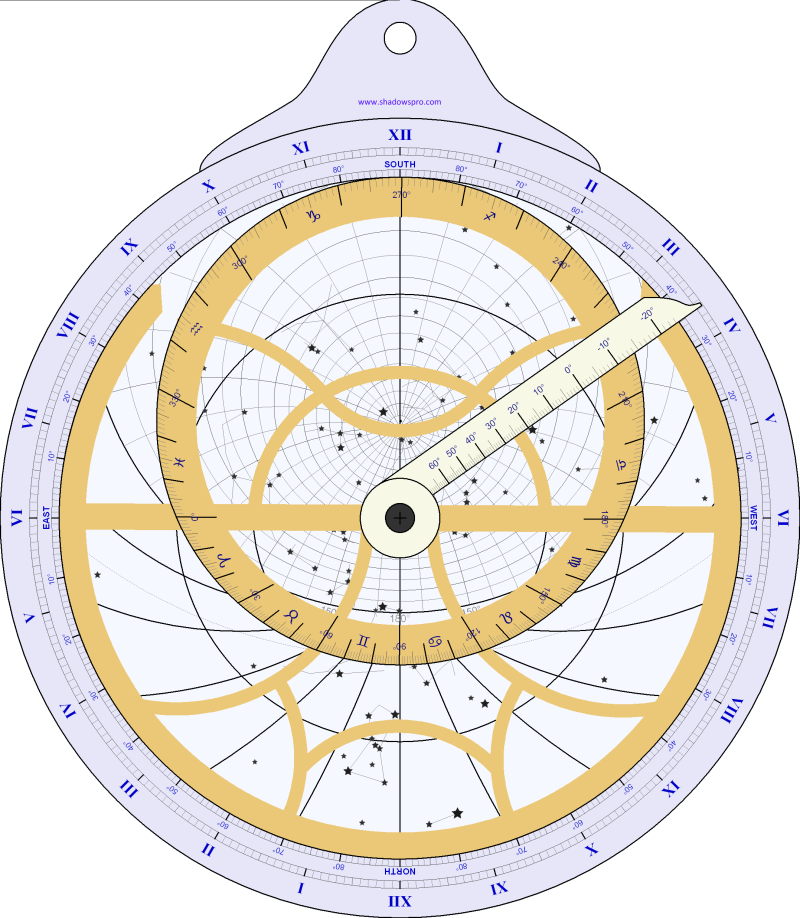Astrolabes are amongst the most sophisticated scientific instruments ever made. Sometimes referred to as an ancient astronomical computer, a “mathematical jewel,” or an analog calculator, the astrolabe is a multi-functional measuring instrument used by astronomers, navigators, and astrologers which enables the user to perform such tasks as telling the time at day or night, surveying, ascertaining the time of sunrise or sunset, determining latitude and longitude, and even producing horoscopes. Any instrument used to measure altitudes above the horizon can be called an astrolabe, although there is a major difference between the classic “planispheric astrolabe” and a “mariner’s astrolabe.”
“Astrolabes are used to show how the sky looks at a specific place at a given time. This is done by drawing the sky on the face of the astrolabe and marking it so positions in the sky are easy to find. To use an astrolabe, you adjust the moveable components to a specific date and time. Once set, the entire sky, both visible and invisible, is represented on the face of the instrument. This allows a great many astronomical problems to be solved in a very visual way… The typical astrolabe was not a navigational instrument, although an instrument called the mariner’s astrolabe was widely used. The mariner’s astrolabe is simply a ring marked in degrees for measuring celestial altitudes” ).
The planispheric astrolabe was invented in classical Greece by Hipparchus, a 2nd century BC astronomer, or by Appolonius of Perga, a 3rd century mathematician, depending on which source you read. During the Islamic Golden Age (~8th-11th century, while Europe was still in the “Dark Ages”), the Muslims preserved and advanced many of the scientific inventions of classical antiquity, including astrolabes which were used for navigation as well as finding the direction of Mecca. “The first person credited with building the astrolabe in the Islamic world is reportedly the eighth century mathematician, Muhammad al-Fazari. The mathematical background was established by the Arab astronomer, Muhammad ibn Jābir al-Harrānī al-Battānī (Albatenius), in his treatise Kitab az-Zij (ca. 920 AD)…In the 10th century, al-Sufi first described over 1,000 different uses of an astrolabe, in areas as diverse as astronomy, astrology, horoscopes, navigation, surveying, time keeping, prayer, Salah, Qibla, etc” (http://www.absoluteastronomy.com/topics/Astrolabe).
Improved Islamic astrolabes were introduced to the West with the spread of Islam in Southern Europe from the tenth century on. “Abū Ishāq Ibrāhīm al-Zarqālī (Arzachel) of Al-Andalus constructed the first universal astrolabe instrument which, unlike its predecessors, did not depend on the latitude of the observer, and could be used from anywhere on the Earth. This instrument became known in Europe as the Saphaea. The astrolabe was introduced to other parts of Western Europe via Al-Andalus in the 11th century…The spherical astrolabe, a variation of both the astrolabe and the armillary sphere, was invented during the Middle Ages by astronomers and inventors in the Islamic world. The earliest description of the spherical astrolabe dates back to Al-Nayrizi (fl. 892-902). In the 12th century, Sharaf al-Dīn al-Tūsī invented the linear astrolabe, sometimes called the ‘staff of al-Tusi’, which was ‘a simple wooden rod with graduated markings but without sights. It was furnished with a plumb line and a double chord for making angular measurements and bore a perforated pointer. The first geared mechanical astrolabe was later invented by Abi Bakr of Isfahan in 1235″ (Wikipedia)
“The astrolabe was widely used in Europe in the late Middle Ages and Renaissance, peaking in popularity in the 15th and 16th centuries, and was one of the basic astronomical education tools. A knowledge of astronomy was considered to be fundamental in education and skill in the use of the astrolabe was a sign of proper breeding and education. Their primary use was, however, astrological. Geoffrey Chaucer thought it was important for his son to understand how to use an astrolabe, and his 1391 treatise on the astrolabe demonstrates a high level of astronomical knowledge… The use of the astrolabe declined in the last half of the 17th century. The invention of the pendulum clock made clocks much more reliable, and more specialized and accurate scientific devices, such as the telescope, became available. Astrolabe production continued into the 19th century, particularly in the Arab world. Much like sundials, any instruments made today are for curiosity or fun, although the educational value of the astrolabe is still appreciated” ).
Article by Bill Norrington






